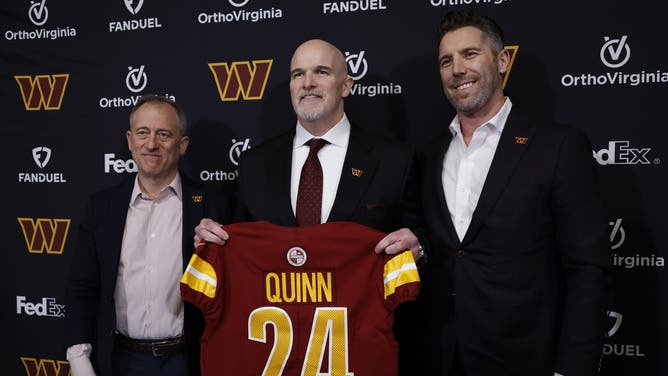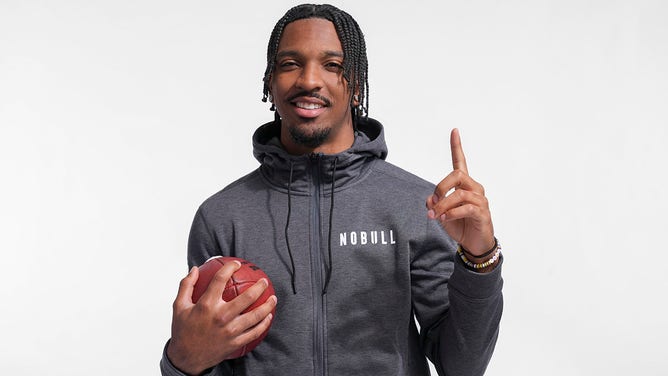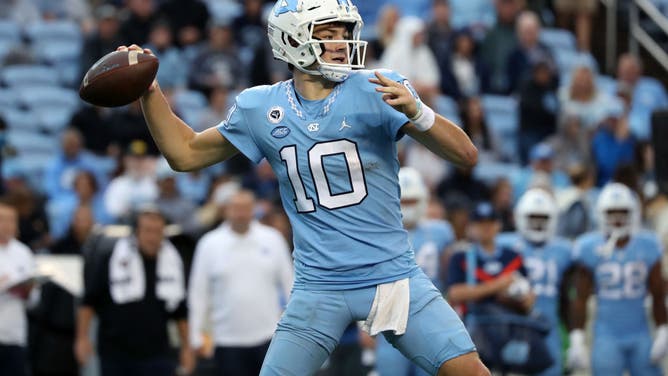Did The Commanders Just Conduct A Sociological Exercise To Determine What QB To Pick?
This column is about the Washington Commanders picking one of the four top quarterbacks in next week's NFL draft, so let me begin at the most logical spot, which is by discussing wolves.
When two alpha wolves meet, animal behaviorists say the typical outcome is the animals are going to size each other up, probably attempt to display dominance, and perhaps even get into a round of full-on aggression.
That's because there can only be one alpha male in a pack. And the choice sorts itself out pretty quickly through various behavior.

Feb 27, 2024; Indianapolis, IN, USA; Washington Commanders general manager Adam Peters talks to the media at the 2024 NFL Combine at Indiana Convention Center. Mandatory Credit: Trevor Ruszkowski-USA TODAY Sports
GM Adam Peters Conducts Interviews
NFL starting quarterbacks are not wolves, but the entire Earth understands that guy has to be a leader. He has to have a personality that rallies people around and behind him.
The most successful ones are often alpha people. And when they're around teammates, everyone quickly figures out who's the leader of the pack.
That brings us to the Commanders and what they did on Wednesday in flying Jayden Daniels, J.J. McCarthy, Drake Maye and Michael Penix Jr. into town as part of two dozen players on their 30 visits.
This, by the way, is not typical.
What often happens when teams need to find a starting quarterback is they visit with as many as they believe might be worthy of their selection and take the measure of the young man individually.
Yes, sometimes other players also are visiting the team in its facility at that same time. But concurrently bringing in four guys vying to play the sport's ultimate leadership position at the same time?
That's not how it's often done.

Feb 5, 2024; Ashburn, VA, USA; Washington Commanders head coach Dan Quinn (M) poses for a picture with Commanders managing partner Josh Harris (L) and Washington Commanders general manager Adam Peters (R) at an introductory press conference at Commanders Park. Mandatory Credit: Geoff Burke-USA TODAY Sports
Josh Harris Schedule Behind Mass Meeting?
So why did Commanders general manager Adam Peters do this? There are probably a couple of reasons and one of them has to do with owner Josh Harris.
"Look, I talked to Adam the other day about having those guys in there," NFL Network draft analyst Daniel Jeremiah said on a conference call Wednesday. "They've done it in San Francisco, and there's value there. He didn't mention this, but I know from being around other teams, that a lot of times that can be a way to cater to the owner.
"The owner might not be in town in the building on a day-to-day basis, so it's a way to be efficient for these guys to come in and meet the owner. He can get a feel for them. I think that's some of the philosophy behind bringing those guys together."
That makes sense. The Commanders are basically killing four proverbial birds (this is a column with many animals) with one stone.
But the dynamics of that offers some amazing sociological possibilities, too.

INDIANAPOLIS, INDIANA - FEBRUARY 29: Jayden Daniels #QB01 of LSU poses for portraits at the Indiana Convention Center on February 29, 2024 in Indianapolis, Indiana. (Photo by Todd Rosenberg/Getty Images)
QB Prospects Interact In Washington
There was apparently a good bit of time in which the prospects – one of which will likely be picked by the Commanders with the No. 2 overall selection – could interact. The group, for example, went to dinner together.
And like competing alpha wolves they tore each other up over a moose carcass.
No they didn't.
There was, according to one source, actually appreciation and respect and good vibes among the group.
But the whole time Penix, Daniels, McCarthy, and Maye were on their visit, they were under the watchful eyes of Washington personnel. They interacted with each other and with the Commanders' staff individually and as a group.
And, while no one within the organization is saying this even privately, would you be surprised if those interactions were being carefully gauged? Measured?

Drake Maye visits the Commanders. (Photo by Andy Mead/ISI Photos/Getty Images)
Drake Maye Among The Visitors
Look, it is not uncommon in human social and professional settings that when two alpha personalities occupy the same space, somebody is usually going to shrink while someone else takes the lead.
So it wouldn't surprise if the Commanders were looking for hints of that. To see which of their top QB candidates was the center of influence. The leader among leaders.
That exercise probably wouldn't determine Washington's pick. It's unlikely to mean if Penix was the alpha throughout the day, he's going to be selected No. 2 because that probably isn't in the cards based on other factors.
But teams absolutely gauge behavior and how players relate to other people on visits. They measure how prospects treat the interns that drive them to their building. They compare answers to the same question from high-ranking and then lower-ranking club officials.
And, for quarterbacks, they look for signs that suggest they're getting a leader off the field as well as on. It's kind of like how wolves measure each other – except there's not as much drooling and growling.